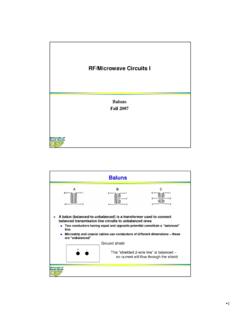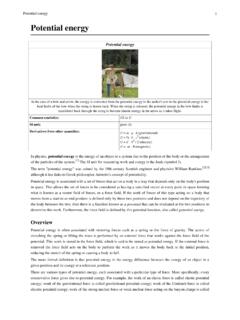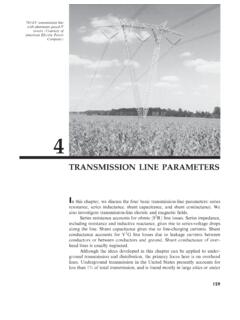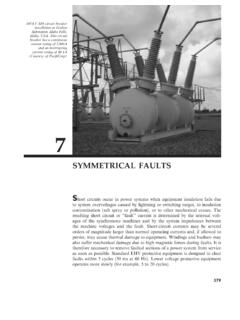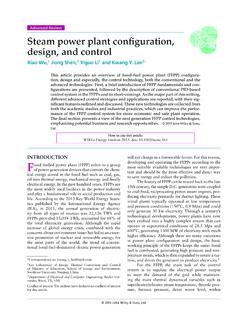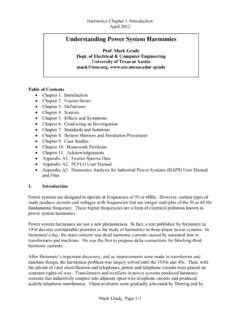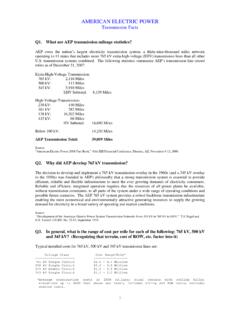Transcription of UNSYMMETRICAL FAULTS - Baylor University
1 The converter switch yardat Bonneville PowerAdministrations CeliloConverter Station in TheDallas, OR, USA. Thisstation converts ac power toHVDC for transmission ofup to 1,440 MW at 400KV over an 856-m16 bipolarline between the Dallas, ORand Los Angeles, CA(AP Photo/Rick Bowmer/CP Images)9 UNSYMMETRICAL FAULTSS hort circuits occur in three-phase power systems as follows, in order offrequency of occurrence: single line-to-ground, line-to-line, double line-to-ground, and balanced three-phase FAULTS . The path of the fault current mayhave either either zero impedance, which is called aboltedshort circuit, ornonzero impedance. Other types of FAULTS include one-conductor-open andtwo-conductors-open, which can occur when conductors break or when oneor two phases of a circuit breaker inadvertently the three-phase short circuit occurs the least, we considered itfirst, in Chapter 7, because of its simplicity.
2 When a balanced three-phasefault occurs in a balanced three-phase system, there is only positive-sequencefault current; the zero-, positive-, and negative-sequence networks are com-pletely an UNSYMMETRICAL fault occurs in an otherwise balanced system,the sequence networks are interconnected only at the fault location. As such,471the computation of fault currents is greatly simplified by the use of in the case of balanced three-phase FAULTS , UNSYMMETRICAL faultshave two components of fault current: an ac or symmetrical component including subtransient, transient, and steady-state currents and a dc com-ponent. The simplified E/X method for breaker selection described in is also applicable to UNSYMMETRICAL FAULTS . The dc o set current need not beconsidered unless it is too large for example, when the X/R ratio is too begin this chapter by using the per-unit zero-, positive-, andnegative-sequence networks to represent a three-phase system.
3 Also, we makecertain assumptions to simplify fault-current calculations, and briefly reviewthe balanced three-phase fault. We present single line-to-ground, line-to-line,and double line-to-ground FAULTS in Sections , , and The use of thepositive-sequence bus impedance matrix for three-phase fault calculations inSection is extended in Section to UNSYMMETRICAL fault calculations byconsidering a bus impedance matrix for each sequence network. Examplesusing PowerWorld Simulator, which is based on the use of bus impedancematrices, are also included. The PowerWorld Simulator computes sym-metrical fault currents for both three-phase and UNSYMMETRICAL FAULTS . TheSimulator may be used in power system design to select, set, and coordinateprotective STUDYWhen short circuits are not interrupted promptly, electrical fires and explosions can minimize the probability of electrical fire and explosion, the following are recommended:Careful design of electric power system layoutsQuality equipment installationPower system protection that provides rapid detection and isolation of FAULTS (seeChapter 10)Automatic fire-suppression systemsFormal maintenance programs and inspection intervalsRepair or retirement of damaged or decrepit equipmentThe following article describes incidents at three utilities during the summer of1990 [8].
4 Fires at UtilitiesGLENN ZORPETTEE lectrical fires in substations were the cause ofthree major midsummer power outages in theUnited States, two on Chicago s West Side and onein New York City s downtown financial district. InChicago, the trouble began Saturday night, July 28,with a fire in switch house No. 1 at the Common-wealth Edison Co. s Crawford substation, accordingto spokesman Gary Wald.( Fires at Utilities by Glenn Zorpette.>1991 , with permission, fromIEEE Spectrum, 28,1 (Jan/1991), pg. 64)472 CHAPTER 9 UNSYMMETRICAL FAULTSSome 40,000 residents of Chicago s West Sidelost electricity. About 25,000 had service restoredwithin a day or so and the rest, within three , as part of the restoration, CommonwealthEdison installed a temporary line configurationaround the Crawford substation. But when a secondfire broke out on Aug. 5 in a different, nearby sub-station, some of the protective systems that wouldhave isolated that fire were inoperable because ofthat configuration.
5 Thus, what would have been aminor mishap resulted in a one-day loss of power to25,000 customers the same 25,000 whose elec-tricity was restored first after the Crawford New York outage began around midday onAug. 13, after an electrical fire broke out in switch-ing equipment at Consolidated Edison s Seaportsubstation, a point of entry into Manhattan for five138-kilovolt transmission lines. To interrupt theflow of energy to the fire, Edison had to disconnectthe five lines, which cut power to four networksin downtown Manhattan, according to Con Edspokeswoman Martha was restored to three of the networkswithin about five hours, but the fourth network,Fulton which carried electricity to about 2400separate residences and 815 businesses was outuntil Aug. 21. Liipfert said much of the equipment inthe Seaport substation will have to be replaced, atan estimated cost of about $25 concern about underground electricalvaults in some areas was tragically validated by anexplosion in Pasadena, Calif.
6 , that killed three cityworkers in a vault. Partly in response to the ex-plosion, the California Public Utilities Commissionadopted new regulations last Nov. 21 requiring thatutilities in the state set up formal maintenance pro-grams, inspection intervals, and guidelines for re-jecting decrepit or inferior equipment. They haveto maintain a paper trail, and we as a commissionwill do inspections of underground vaults and re-view their records to make sure they re maintainingtheir vaults and equipment in good order, said RussCopeland, head of the commission s utility REPRESENTATIONA three-phase power system is represented by its sequence networks inthis chapter. The zero-, positive-, and negative-sequence networks of systemcomponents generators, motors, transformers, and transmission lines asdeveloped in Chapter 8 can be used to construct system zero-, positive-, andnegative-sequence networks.
7 We make the following power system operates under balanced steady-state condi-tions before the fault occurs. Thus the zero-, positive-, and negative-sequence networks are uncoupled before the fault occurs. Duringunsymmetrical FAULTS they are interconnected only at the load current is neglected. Because of this, the positive-sequence internal voltages of all machines are equal to the pre-fault voltageVF. Therefore, the prefault voltage at each bus in thepositive-sequence network winding resistances and shunt admittances SYSTEM series resistances and shunt admittances machine armature resistance, saliency, and saturationare nonrotating impedance loads are motors are either neglected (especially for motors rated50 hp (40 kW) or less) or represented in the same manner as syn-chronous that these assumptions are made for simplicity in this text, and inpractice should not be made for all cases.
8 For example, in primary and sec-ondary distribution systems, prefault currents may be in some cases com-parable to short-circuit currents, and in other cases line resistances maysignificantly reduce fault fault currents as well as contributions to fault currents on thefault side ofD Y transformers are not a ected byD Y phase shifts, contri-butions to the fault from the other side of such transformers are a ected byD Y phase shifts for UNSYMMETRICAL FAULTS . Therefore, we includeD Y phase-shift e ects in this consider FAULTS at the general three-phase bus shown in Figure , denoted thefault terminals, are brought out in order to makeexternal connections that represent FAULTS . Before a fault occurs, the currentsIa;Ib, andIcare (a) shows general sequence networks as viewed from the faultterminals. Since the prefault system is balanced, these zero-, positive-, and neg-ative-sequence networks are uncoupled.
9 Also, the sequence components of thefault currents,I0;I1,andI2, are zero before a fault occurs. The general se-quence networks in Figure (a) are reduced to their The venin equivalents asviewed from the fault terminals in Figure (b). Each sequence network hasaThe venin equivalent impedance. Also, the positive-sequence network has aThe venin equivalent voltage source, which equals the prefault three-phase bus474 CHAPTER 9 UNSYMMETRICAL FAULTSEXAMPLE Power-system sequence networks and their The venin equivalentsA single-line diagram of the power system considered in Example isshown in Figure , where negative- and zero-sequence reactances are alsogiven. The neutrals of the generator andD Y transformers are solidlygrounded. The motor neutral is grounded through a reactance Xn 0:05 perunit on the motor base. (a) Draw the per-unit zero-, positive-, and negative-sequence networks on a 100-MVA, base in the zone of the generator.
10 (b) Reduce the sequence networks to their The venin equivalents, as viewedfrom bus 2. Prefault voltage isVF 1:050 per unit. Prefault load currentandD Y transformer phase shift are networks at ageneral three-phase busin a balanced systemFIGURE diagram forExample SYSTEM sequence networks are shown in Figure The positive-sequencenetwork is the same as that shown in Figure (a). The negative-sequencenetwork is similar to the positive-sequence network, except that there areno sources, and negative-sequence machine reactances are Yphase shifts are omitted from the positive- and negative-sequence networksfor this example. In the zero-sequence network the zero-sequence genera-tor, motor, and transmission-line reactances are shown. Since the motorneutral is grounded through a neutral reactance Xn;3 Xnis included in thezero-sequence motor circuit.
